Abstract
The extremal problem of Laplacian permanents of graphs is a classical and challenging topic in algebraic combinatorics, where the inherent #P-complete complexity of permanent computation renders this pursuit particularly intractable. In this paper, we determine the upper and lower bounds of permanents of Laplacian matrices of unicyclic graphs, and the corresponding extremal graphs are characterized. Furthermore, we also determine the upper and lower bounds of permanents of Laplacian matrices of unicyclic graphs with given girth, and the corresponding extremal graphs are characterized.
MSC:
05C50; 05E05; 15A15
1. Introduction
Let be a simple connected graph with vertex set and edge set . Suppose the degree of vertex equals (simply written as ) for . The Laplacian matrix is defined by
The matrix is called the signless Laplacian matrix of G whose entries are the absolute values of the entries of . The Laplacian matrix has been the object of considerable study, stimulated in part by Fiedler’s algebraic connectivity [1] and in part by applications in chemistry [2], statistics [3], and parallel algorithms for sparse matrix computations [4].
For an matrix , the permanent is defined as
where the sum is taken over all permutations of the set . In general, the problem of evaluating the permanent of a given matrix is known to be very difficult and was proved to be a #P-complete problem [5]. In view of the computational difficulty, a considerable number of researchers have been devoted to the determination of good bounds for permanents for matrices; see [6,7,8]. Often, the problem of determining the upper bound or lower bound of the permanent over a certain class of matrices is the same as that of maximizing or minimizing the permanent over the same class of matrices. Brualdi and Goldwasser [9] characterized the bounds of the permanents of the Laplacian matrix (simply written as Laplacian permanents) of trees or of trees with given graph parameters. Geng et al. [10,11] obtained the lower bounds of the Laplacian permanents of trees with graph parameters (such as numbers of pendent vertices, maximum degree, and domination number), and the corresponding extremal graphs were characterized. Perhaps due to the notorious computational intractability of the permanent, this work seems to have stalled.
A unicyclic graph G is a simple connected graph in which the number of edges is equal to the number of vertices. This implies that a unicyclic graph contains exactly one cycle. Li and Zhang [12,13] characterized the upper and lower bounds for signless Laplacian permanents of unicyclic graphs, and they characterized lower bounds for signless Laplacian permanents of unicyclic graphs with given girth or diameter. Vrba [14] proved that the Laplacian permanents and signless Laplacian permanents are equal for bipartite graphs. This means that the bound of the Laplacian permanents for non-bipartite unicyclic graphs is unknown, i.e.,
Problem 1.
Determining bounds for the Laplacian permanents of non-bipartite unicyclic graphs.
In this paper, our interest is to characterize the bounds of the Laplacian permanents of unicyclic graphs or unicyclic graphs with given graph parameters, and at the same time, provide the solution to Problem 1. For the sake of convenience, we will first introduce several definitions and notations. Let , , and denote the cycle, path, star, and complete graph, respectively, each having n vertices. Let be a graph constructed by attaching pendent edges to a vertex of ; see Figure 1. Let be a graph formed by attaching pendent edges to a vertex of ; see Figure 1. We denote by a graph obtained by joining a vertex of to an end vertex of ; see Figure 1. Denote the set of unicyclic graphs with n vertices by , and let denote the set of unicyclic graphs on n vertices with girth k. Let be a vertex subset. We use to denote the principal submatrix of that is formed by deleting the rows and columns corresponding to all vertices of . In particular, if with , then is simply written as . denotes the vertex set of the induced cycle C of G. Let and be the graphs obtained by removing the edge e and vertex v from G, respectively. Based on the above definitions and notations, the main results we have obtained in this paper are as follows.

Figure 1.
Graphs , and .
Theorem 1.
Let be a unicyclic graph with n vertices. Then
where the left equality holds if and only if , and the right equality holds if and only if .
Theorem 2.
Let be a unicyclic graph with n vertices and girth k. Then
where the left equality holds if and only if , and the right equality holds if and only if .
To help readers understand Theorems 1 and 2, we have enumerated all unicyclic graphs with five vertices (see Figure 2), whose permanents are , , , , and , respectively. Observing the structures of , , and , we have , , and . It is easy to see that is the largest and is the smallest, which is consistent with Theorem 1. For the case where the girth is 3, it is similarly easy to observe that is the largest and is the smallest, and this is consistent with Theorem 2.

Figure 2.
All unicyclic graphs with five vertices.
The organization of this paper is structured as follows. In Section 2, we will introduce some lemmas. In Section 3, we will present the proof of Theorem 1. Precisely, the upper and lower bounds of the Laplacian permanents of unicyclic graphs are ascertained. In Section 4, the proof of Theorem 2 will be given, wherein the upper and lower bounds of the Laplacian permanents of unicyclic graphs with a specified girth are determined. In Section 5, a brief summary is provided.
2. Preliminary
In this section, several lemmas are crucial for the description and proof of our subsequent results. We list them as follows.
Lemma 1.
Let , where , be an square matrix. Then
Lemma 2
([15]). Let M be a positive semidefinite matrix. Then
Lemma 3
([9]). Let T be a tree with n vertices. Then
Lemma 4
([9]). Let T be a tree with n vertices. Then
Lemma 5
([9]). Let be the path with n vertices. Let be the matrix obtained from by eliminating row and column of one of the end vertices. Then
- (i)
- ,
- (ii)
- ,
- (iii)
- ,
where .
Lemma 6
([9]). Let G be a graph with n vertices. Then
Lemma 7
([12]). Let G be a unicyclic graph with n vertices. Then
Lemma 8
([16]). Let G be a simple graph, v be a vertex of graph G, be the set of cycles in graph G that contain vertex v, and denote the neighborhood of v. Then
Lemma 9
([16]). Let G be a simple connected graph with . Suppose that and is the set of cycles containing the edge e in G. Then
Lemma 10
([16]). Let G be a simple connected graph with . Suppose that and S is a proper subset of satisfying . Then
Lemma 11
([16]). Let G be a simple connected graph with . If v is a pendant vertex of G, and u is the vertex adjacent to v. Then each of the following holds.
- (i)
- ,
- (ii)
- (iii)
Lemma 12
([17]). Let T be a tree with vertices, and . Then
Lemma 13.
Let T be a tree with n vertices. Then every term in the expansion of , and the permanent of every principal submatrix of , is non-negative.
Proof.
Suppose that , , …, . Consider a term in the expansion of , where is the -entry of . Note that , and when , if , then ; otherwise . Hence if , then or for all . We think of as a product of disjoint cycles. Each cycle corresponds to either or , where and . Hence, we deduce that each term in the Laplace expansion of is a non-negative integer. By the definitions of , and each term in the Laplace expansion of is a non-negative integer, we obtain that each term in the Laplace expansion of is also a non-negative integer. □
Lemma 14
([17]). Let T be a tree with vertices, and let v be a pendant vertex of T, , . Then
Lemma 15.
Let T be a tree with n vertices, , . Let be the connected components of . Denote as the subgraph of T induced by (). Then
Proof.
The matrix has the following form
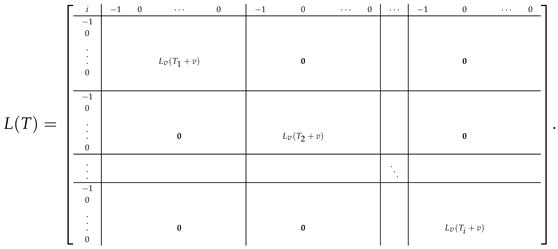 By Lemma 1, it can be shown that
By Lemma 1, it can be shown that

□
Lemma 16.
Let T be a tree with vertices. Let v be a pendant vertex of T. Then
Proof.
We are to prove the lemma by induction on . If , it can be easily verified through simple calculations that the conclusion holds. Assume it is true for with , and let . Let u be the neighbor of v. According to Lemma 11, we have
Suppose that . By the induction hypothesis, we have . By Lemma 4, we have
Suppose that . By Lemma 14, we have
where is a pendant vertex of . By the induction hypothesis, we have
Hence . □
3. Proof of Theorem 1
In this section, we will give the proof of Theorem 1. Before proceeding to the proof of Theorem 1, we first introduce some lemmas.
Lemma 17.
Let G be a unicyclic graph with n vertices. If is a pendant vertex of G, and is the vertex adjacent to . Then
where is the degree of .
Proof.
Let be the connected component of . Denote as the subgraph of G induced by . The matrix has the following form
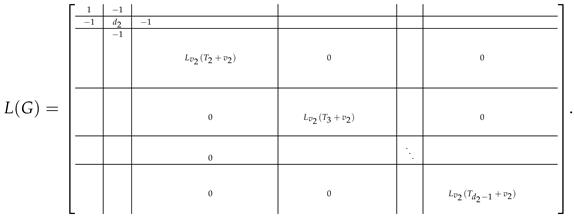

Suppose that is the vertex of the unique cycle in G. By Lemmas 1 and 15, we have
By the definition of , is either a tree or a unicyclic graph with on the unique cycle in . If is a tree, by Lemma 13, each term of is a non-negative integer. If is a unicyclic graph with on the unique cycle in , then can be regarded as a principal submatrix of the Laplacian matrix of a tree; thus, by Lemma 13, each term of is a non-negative integer. Moreover, since the product of principal diagonal element is a term in the Laplace expansion of , it follows that is greater than or equal to the product of the principal diagonal element. Hence
Suppose that is not a vertex of the unique cycle in G. Let be vertex of the unique cycle in G. By Lemma 10, we have
From the arguments as above, we know that each term in the Laplace expansions of , , and is non-negative. Hence, each of , , and is greater than the product of its main diagonal elements. This implies that . By the structure of G, we know that . We can definitely find a vertex (different from and ) on the unique cycle of G such that
Hence
By Lemma 10, we obtain that
□
Lemma 18.
Let n be a positive integer. Then
Proof.
Let be an edge of . By Lemma 9, we have
Let be the matrix obtained by deleting the first row and column of . Then, expanding the permanent of along the first row we obtain
This recurrence relation along with and determines for all . For later use we define so that (3) holds for all as well. This recurrence relation can be solved using standard procedures to obtain the following formula:
By Lemmas 4 and 5 and (4), we have
□
Lemma 19.
Let n be a positive integer. Then
Proof.
Let be an edge of , where . By Lemmas 3 and 9, we have
□
Next, we give the proof of Theorem 1.
Proof of Theorem 1.
First, we prove the right inequality in (2). Suppose that G contains a unique cycle of even length. Then, G is a bipartite graph. By Lemmas 6 and 7, the conclusion holds. Next we consider G contains a unique cycle of odd length. Suppose , and is an edge of the unique cycle in G. By Lemma 9, we have
It is obvious that the graph is a tree with n vertices. Therefore, by Lemmas 4, 5, 11, and 16, we have
Hence
Hence, for any , we have
Next, we prove the left inequality in (2) by induction on . If , since G is unicyclic graph, it follows from the definition of unicyclic graph that G is isomorphic to . Hence, in this case our result holds. Next, we consider the case where . Assume that the result holds for . We will prove that it holds for . Suppose that there is no pendant vertex in G, then . Obviously, . Therefore, assume that the unicyclic graph G has at least one pendant vertex , and denote its neighbor by . By Lemma 11, we have
Since , by the induction hypothesis, we have
Suppose that ; the left inequality in (2) holds.
Suppose that . This implied that there is no vertex in G such that its degree is at least . Hence
where is the degree of . By Lemma 17, we have
Since , there are at least three vertices in G with a degree of at least 2, obviously, . Now assume that and are vertices in G satisfying and . Suppose that . Then there must exist a vertex such that . Otherwise , which contradicts to (8). Therefore, by (9), we have
4. Proof of Theorem 2
In this section, we will give the proof of Theorem 2. Before proceeding to the proof of Theorem 2, we first prove some lemmas.
Lemma 20.
Let n and k be positive integers. Then
Proof.
Assume that and . By Lemma 8, we have
The proof of the lemma is completed. □
Lemma 21.
Let n and k be positive integers. Then
Proof.
□
Definition 1.

Let G be a unicyclic graph. Suppose that is a pendant path of G satisfying , , and . Assume is a pendant vertex of G. is a unicyclic graph obtained from G by deleting the vertices and w. Let be a unicyclic graph obtained from G by deleting the edge and adding the edge . These resulting graphs are illustrated in Figure 3. We say is obtained from G by
Operation 1.

Figure 3.
by operation 1.
Lemma 22.
Let G and be two graphs defined as above. Then
Proof.
Firstly, we assume that . Given a proper sequence of the vertices of G: , we have
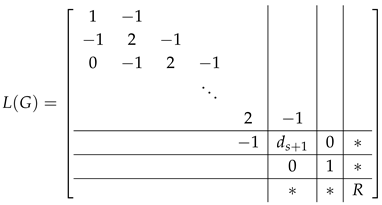 and
and
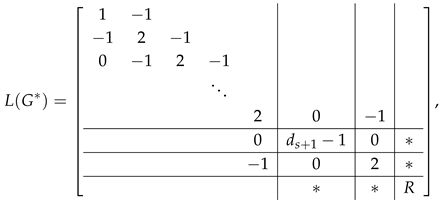 where R is a matrix obtained from by eliminating the first rows and columns. Let (resp. ) be a matrix obtained from (resp. ) by eliminating the first s rows and s columns. Let (resp. ) denote the matrix obtained by deleting the first row and first column from (resp. the second row and second column from ). By Lemma 1, we have
By expanding the permanent of (resp. ) along the first s rows we obtain
Hence
By Lemma 2, we have . Note that and . Hence
By (12) and (13), we have .
where R is a matrix obtained from by eliminating the first rows and columns. Let (resp. ) be a matrix obtained from (resp. ) by eliminating the first s rows and s columns. Let (resp. ) denote the matrix obtained by deleting the first row and first column from (resp. the second row and second column from ). By Lemma 1, we have
By expanding the permanent of (resp. ) along the first s rows we obtain
Hence
By Lemma 2, we have . Note that and . Hence
By (12) and (13), we have .


Now, let . Similarly, given a proper sequence of the vertices of G: , we have
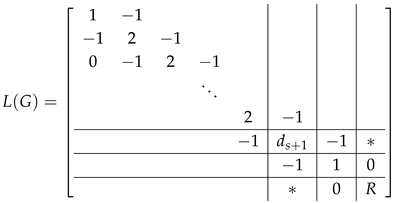 and
and
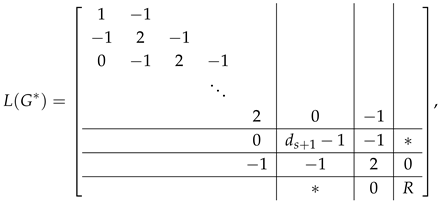 where R is a matrix obtained from by eliminating the first rows and columns. Let (resp. ) be a matrix obtained from (resp. ) by eliminating the first s rows and s columns. Let (resp. ) denote the matrix obtained by deleting the first row and first column from (resp. the second row and second column from ). By Lemma 1, we have
By expanding the permanent of (resp. ) along the first s rows we obtain
Hence
By Lemma 2, we have . Note that and . Hence
By (14) and (15), we have . □
where R is a matrix obtained from by eliminating the first rows and columns. Let (resp. ) be a matrix obtained from (resp. ) by eliminating the first s rows and s columns. Let (resp. ) denote the matrix obtained by deleting the first row and first column from (resp. the second row and second column from ). By Lemma 1, we have
By expanding the permanent of (resp. ) along the first s rows we obtain
Hence
By Lemma 2, we have . Note that and . Hence
By (14) and (15), we have . □


Proof of Theorem 2.
We prove the left inequality by induction on n. Set . By Lemma 20, our result holds in this case. Set . Assume that the conclusion holds for all . Next, we prove that the conclusion holds when . Suppose that is a pendant vertex of G, and is adjacent to . By Lemma 11, we have
and
Since , by the induction hypothesis, we have
To prove that the conclusion holds, it suffices to prove that . We distinguish two cases in the following.
Case 1. There exists at least one pendant vertex attached to the induced cycle in G. In this case, suppose that , and the other vertices of the induced cycle in G are labeled by . Then, contains a submatrix , where
By proof of Lemma 17, we have as a submatrix of the Laplacian matrix of a tree; hence, each term of is non-negative. Hence, .
Case 2. A pendant vertex attached to the induced cycle in G does not exist. In this case, by an appropriate labeling of the vertices of G, the vertices of the induced cycle are labeled successively by . By Lemma 10, we have
Since each term of is non-negative and has a submatrix , we have
By the proof of Lemma 17, we have
Hence
In conclusion,
Next, we prove the right inequality. Suppose that the graph G has exactly one pendant vertex. By , according to the properties of this graph class, we can conclude that , and thus the theorem holds. Suppose that G has at least two pendent vertices. In the first step, by Operation 1, the subtrees hanging on the vertex in induced cycle of G are transformed into paths with the corresponding number of vertices. Repeated applications of Operation 1, transform all subtrees hanging on the vertex in induced cycle of G into pendant paths. In the second step, by applying Operation 1 to merge the aforementioned pendant paths, we successfully derive the extremal graph . By Lemma 22, it can be known that the right inequality holds. □
5. Conclusions
In this work, we establish rigorous bounds for Laplacian permanents of unicyclic graphs and provide a complete resolution to Problem 1. Meanwhile, we completely characterize the bounds of unicyclic graphs with a given girth. Notably, our derived bounds for Laplacian permanents differ fundamentally from those established by Li and Zhang [12] for unsigned Laplacian permanents in analogous graph structures. The bounds presented in this paper accurately express the value of the Laplacian permanent of unicyclic graphs, which is extremely difficult given that the computation of the Laplacian matrix permanent is #P-complete. Additionally, they provide an effective theoretical basis for researching the accuracy of permanent approximation algorithms. Building upon Brualdi’s open problem regarding matrix permanents [9], we identify several promising research directions in this domain. Specifically, characterizing extremal values of Laplacian permanents under structural constraints including fixed matching numbers, bipartition parameters, and diameter bounds emerges as particularly compelling. These problems will constitute the primary focus of subsequent investigations, potentially yielding new insights into the combinatorial properties of graph permanents.
Author Contributions
All the authors contributed equally to this work. All authors have read and agreed to the published version of the manuscript.
Funding
Supported by the National Natural Science Foundation of China (No. 12261071) and Natural Science Foundation of Qinghai Province (No. 2025-ZJ-902T).
Data Availability Statement
No data were used to support this study.
Conflicts of Interest
The authors declare no conflicts of interest.
References
- Fiedler, M. Algebraic connectivity of graphs. Czech. Math. J. 1973, 23, 298–305. [Google Scholar] [CrossRef]
- Eichinger, B. Configuration statistics of Gaussian molecules. Macromolecules 1980, 13, 1–11. [Google Scholar] [CrossRef]
- Constantine, G. Graph complexity and the Laplacian matrix in blocked experiments. Linear Mulitilinear Algebra 1990, 28, 49–56. [Google Scholar] [CrossRef]
- Pothen, A.; Simon, H.; Liou, K. Partitioning sparse matrices with eigenvectors ofgraphs. SIAM J. Matrix Anal. Appl. 1990, 11, 430–452. [Google Scholar] [CrossRef]
- Valiant, L.G. The complexity of computing the permanent. Theoret. Comput. Sci. 1979, 8, 189–201. [Google Scholar] [CrossRef]
- Samorodnitsky, A. An upper bound for permanents of nonnegative matrices. J. Combin. Theory Ser.A 2008, 115, 279–292. [Google Scholar] [CrossRef]
- Soules, G.W. Permanental bounds for nonnegative matrices via decomposition. Linear Algebra Appl. 2005, 394, 73–89. [Google Scholar] [CrossRef]
- Wanless, I.M. Maximizing the permanent at the complementary permanent of (0,1)-matrices with constant line sum. Discrete Math. 1999, 205, 191–205. [Google Scholar] [CrossRef]
- Brualdi, R.A.; Goldwasser, J.L. Permanent of the Laplacian matrix of trees and bipartite graphs. Discrete Math. 1984, 48, 1–21. [Google Scholar] [CrossRef]
- Geng, X.; Hu, X.; Li, S. Further results on permanental bounds for the Laplacian matrix of trees. Linear Multilinear Algebra 2010, 58, 571–587. [Google Scholar] [CrossRef]
- Geng, X.; Hu, X.; Li, S. Permanental bounds of the Laplacian matrix of trees with given domination number. Graphs Combin. 2015, 31, 1423–1436. [Google Scholar] [CrossRef]
- Li, S.; Zhang, L. Permanental bounds for the signless Laplacian matrix of bipartite graphs and unicyclic graphs. Linear Multilinear Algebra 2011, 59, 145–158. [Google Scholar] [CrossRef]
- Li, S.; Zhang, L. Permanental bounds for the signless Laplacian matrix of a unicyclic graph with diameter d. Graphs Combin. 2012, 28, 531–546. [Google Scholar] [CrossRef]
- Vrba, A. The permanent of the Laplacian matrix of a bipartite graph. Czech. Math. J. 1986, 36, 7–17. [Google Scholar] [CrossRef]
- Bapat, R.B. A bound for the permanent of the Laplacian matrix. Linear Algebra Appl. 1986, 74, 219–223. [Google Scholar] [CrossRef]
- Wu, T.; Dong, X.; Lai, H.; Zeng, X. Solution to an open problem on Laplacian ratio. Front. Math. 2025, 1–23. [Google Scholar] [CrossRef]
- Wu, T.; Dong, X.; Lai, H. Two problems on Laplacian ratios of trees. Discrete Appl. Math. 2025, 372, 224–236. [Google Scholar] [CrossRef]
Disclaimer/Publisher’s Note: The statements, opinions and data contained in all publications are solely those of the individual author(s) and contributor(s) and not of MDPI and/or the editor(s). MDPI and/or the editor(s) disclaim responsibility for any injury to people or property resulting from any ideas, methods, instructions or products referred to in the content. |
© 2025 by the authors. Licensee MDPI, Basel, Switzerland. This article is an open access article distributed under the terms and conditions of the Creative Commons Attribution (CC BY) license (https://creativecommons.org/licenses/by/4.0/).